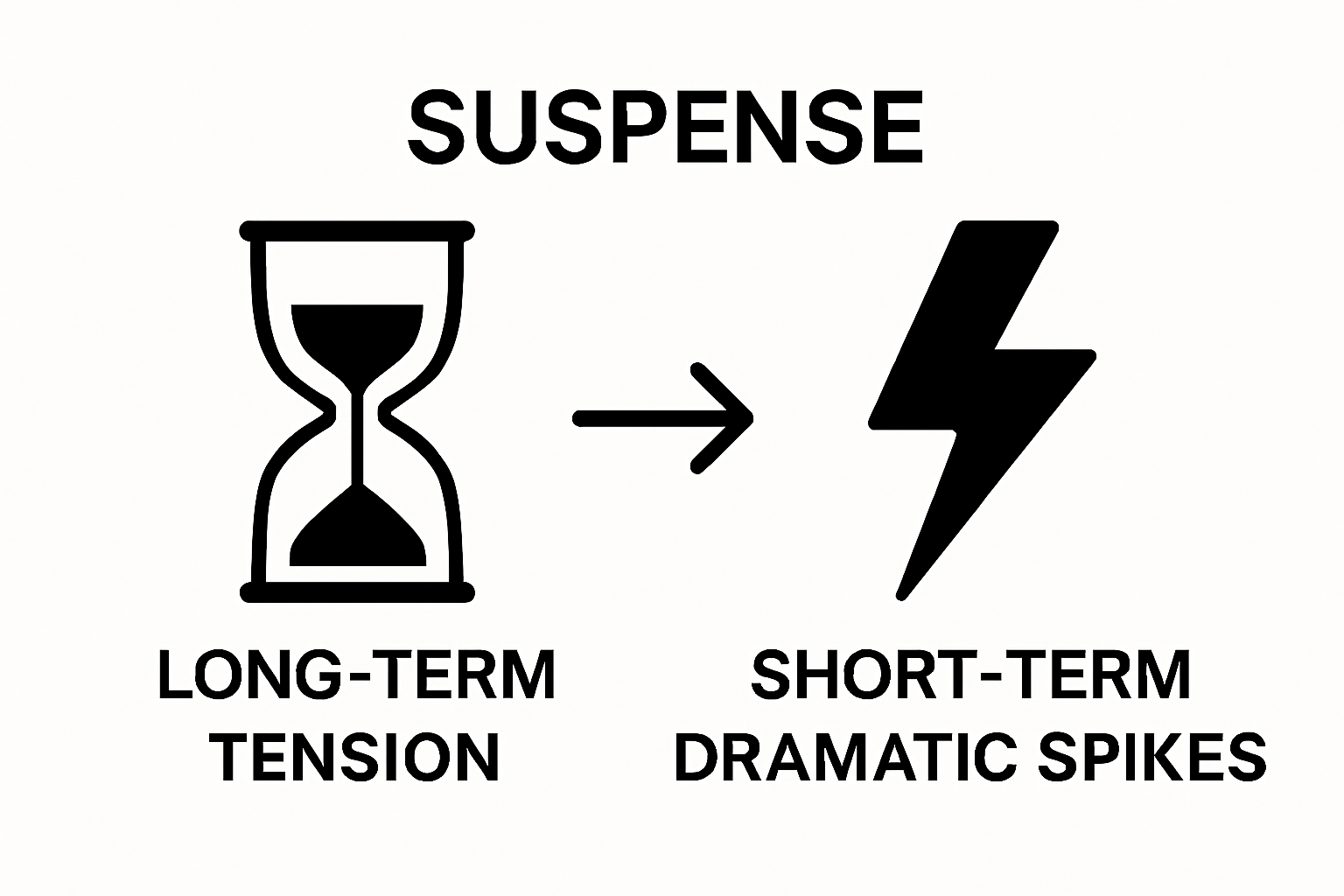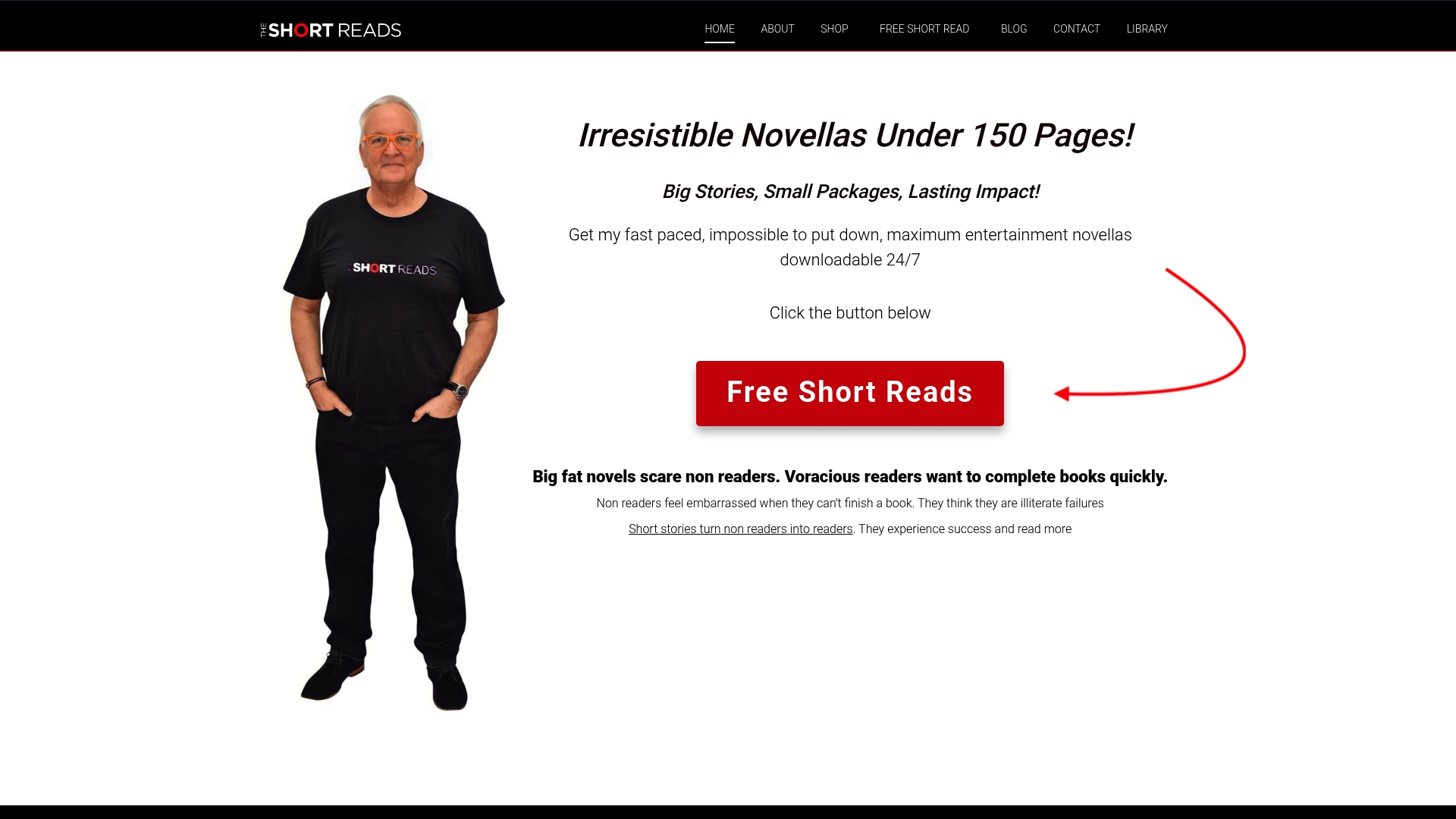Understanding the Role of Suspense in Fiction

Suspense in fiction can make a story almost impossible to put down. Studies show that suspense activates the brain’s reward system, releasing chemicals like dopamine and adrenaline that keep readers hooked. Most people think it is all about big plot twists or shocking reveals, but the real secret is in the carefully crafted uncertainty that keeps you guessing with every page.
Table of Contents
- What Is Suspense In Fiction And Its Purpose?
- Why Suspense Matters: Emotional Engagement And Reader Retention
- How Suspense Works: Techniques And Elements Used By Writers
- Key Concepts Of Suspense: Building Tension And Anticipation
- Real-World Examples: Suspense In Popular Fiction And Its Impact
Quick Summary
| Takeaway | Explanation |
|---|---|
| Suspense enhances reader engagement. | It transforms reading into an emotionally charged experience that maintains interest and participation. |
| Anticipation is crucial for suspense. | Writers create emotional investment by generating uncertainty about character outcomes and narrative developments. |
| Control information disclosure strategically. | Authors maintain narrative tension by deciding when and how much information to reveal to readers. |
| Characters’ motivations are key drivers. | Complex and unpredictable character behaviors foster engagement, encouraging readers to anticipate outcomes. |
| Utilize genre-specific suspense techniques. | Different genres require tailored approaches in building suspense, enhancing the story’s emotional impact. |
What is Suspense in Fiction and Its Purpose?
Suspense is a powerful narrative technique that transforms storytelling from a passive experience into an emotionally charged journey. At its core, suspense represents the deliberate creation of anticipation, uncertainty, and psychological tension that keeps readers intellectually and emotionally invested in a story.
The Psychological Mechanism of Suspense
In fiction, suspense operates as a complex cognitive and emotional mechanism. Research from ResearchGate reveals that suspense generates a unique emotional state characterized by uncertainty about imminent narrative outcomes. This uncertainty triggers a series of psychological responses that compel readers to remain engaged.
The primary psychological triggers of suspense include:
- Anticipation of potential threats or challenges
- Emotional investment in character outcomes
- Cognitive desire to resolve narrative mysteries
Purpose and Strategic Implementation
Suspense serves multiple strategic purposes in fiction beyond mere entertainment. It functions as a narrative tool that:
- Maintains reader engagement through emotional arousal
- Creates intellectual curiosity about potential story developments
- Encourages active reader participation through mental predictions
Authors construct suspense through carefully orchestrated narrative techniques such as strategic information withholding, introducing complex character motivations, and creating scenarios with multiple potential resolutions. By manipulating reader expectations, writers transform storytelling into an interactive experience that goes beyond linear plot progression.
Understanding suspense is crucial for readers and writers alike. For those interested in exploring narrative techniques more deeply, check out our guide on mystery fiction storytelling.
Why Suspense Matters: Emotional Engagement and Reader Retention
Suspense transcends simple narrative technique, serving as a critical psychological mechanism that transforms reading from passive consumption to active emotional experience. By strategically manipulating reader emotions, suspense becomes a powerful tool for maintaining engagement and creating memorable storytelling experiences.
The Neurological Impact of Suspense
Research from Springer reveals that suspense activates complex neurological reward systems, generating a profound emotional and cognitive response. When readers encounter narrative uncertainty, their brains release neurochemicals like dopamine and adrenaline, creating a physiological investment in the story’s progression.
The key neurological responses triggered by suspense include:
- Heightened attention and sensory awareness
- Increased emotional arousal
- Activation of predictive cognitive mechanisms
Psychological Dynamics of Reader Retention
Suspense operates as a sophisticated psychological engagement strategy. By creating deliberate narrative tensions, authors compel readers to remain emotionally connected, transforming potential disengagement into sustained interest. This psychological manipulation ensures readers continue reading to resolve narrative uncertainties.
To clarify how suspense affects both the mind and body, the table below summarizes the neurological and psychological impacts described in the article.
| Aspect | Description |
|---|---|
| Neurological Responses | Suspense activates reward systems, releasing dopamine and adrenaline that heighten focus. |
| Emotional Arousal | Increases excitement and anxiety, driving reader engagement and immersion. |
| Attention & Awareness | Enhances sensory perception and alertness, keeping readers attentive to narrative clues. |
| Predictive Thinking | Engages cognitive mechanisms that make readers guess upcoming events or story outcomes. |
| Reader Retention | Sustains interest by compelling readers to keep reading to resolve uncertainties. |
Authors achieve reader retention through:
- Creating characters with complex, unpredictable motivations
- Introducing strategic plot complications
- Balancing revealed and concealed narrative information
For readers interested in exploring narrative techniques that drive engagement, discover more about story structure secrets that make stories truly captivating.
Ultimately, suspense represents more than a storytelling technique. It is a nuanced emotional contract between writer and reader, promising an experience that will challenge, surprise, and deeply connect through shared anticipation and resolution.
How Suspense Works: Techniques and Elements Used by Writers
Suspense is a meticulously crafted narrative art form that requires strategic manipulation of storytelling elements. Writers employ a sophisticated arsenal of techniques to generate and maintain narrative tension, transforming simple storytelling into an immersive psychological experience.
Narrative Construction Strategies
Research from the Yale National Initiative reveals that suspense emerges through deliberate narrative choices involving point of view, mood, tone, imagery, and symbolism. Each element contributes to creating an atmosphere of uncertainty and anticipation.
Key narrative strategies for generating suspense include:
- Controlling information revelation
- Developing complex character motivations
- Creating strategic narrative gaps
- Establishing unpredictable story trajectories
Technical Manipulation of Reader Expectations
Suspense operates by systematically challenging reader expectations. Writers achieve this through sophisticated techniques like introducing narrative misdirection, creating multiple potential story outcomes, and carefully calibrating the pace of information disclosure.
Critical techniques for maintaining suspense involve:
- Implementing the “ticking clock” scenario
- Introducing high-stakes narrative complications
- Developing morally ambiguous character interactions
For writers seeking deeper insights into crafting compelling narratives, explore our comprehensive guide to mystery fiction techniques.
Ultimately, suspense is an intricate dance between writer and reader, where carefully constructed narrative elements transform storytelling into an emotional and intellectual journey of anticipation and revelation.
Key Concepts of Suspense: Building Tension and Anticipation
Suspense represents a nuanced narrative architecture that transforms storytelling from mere plot progression into a complex emotional landscape. Understanding its fundamental concepts reveals how writers strategically manipulate reader psychology to create compelling narrative experiences.
Foundational Elements of Narrative Tension
At its core, suspense emerges from the deliberate management of narrative uncertainty. Writers create tension by establishing a delicate balance between what readers know and what remains concealed, generating a persistent sense of anticipation and intellectual engagement.
Critical foundational elements include:

- Creating clear but incomplete narrative information
- Establishing significant character stakes
- Developing potential consequences for character actions
- Introducing unexpected narrative complications
Psychological Mechanisms of Anticipation
Suspense operates through sophisticated psychological manipulation. By strategically withholding critical information and presenting complex narrative scenarios, writers activate readers’ natural cognitive desire to predict and resolve story outcomes.
Key psychological triggers of anticipation involve:
- Activating pattern recognition mechanisms
- Stimulating predictive cognitive processes
- Generating emotional investment in narrative resolution
- Creating controlled emotional uncertainty
Learn more about crafting compelling narrative structures that transform basic storytelling into extraordinary reading experiences.
Ultimately, suspense transcends mechanical storytelling techniques. It represents a profound dialogue between writer and reader, where narrative complexity becomes an invitation to emotional and intellectual exploration.
Real-World Examples: Suspense in Popular Fiction and Its Impact
Research from EBSCO reveals suspense as a profound narrative strategy that transforms storytelling across multiple genres, compelling readers through intricate psychological manipulation and strategic narrative design.
Literary Manifestations of Suspense
Suspense emerges through two primary narrative approaches: long-term tension and short-term dramatic spikes. Long-term suspense gradually builds anticipation through unresolved questions, while short-term suspense creates sudden, intense moments of narrative uncertainty.

Notable examples of suspense implementation include:
- Gothic novels like Frankenstein, which establish atmospheric dread
- Mystery narratives by Edgar Allan Poe, featuring psychological complexity
- Contemporary thrillers such as Gone Girl, utilizing unexpected plot reversals
- Psychological novels that explore characters’ internal uncertainties
Genre-Specific Suspense Techniques
Different literary genres deploy suspense uniquely, tailoring narrative tension to specific storytelling conventions. Horror narratives often rely on anticipatory fear, while mystery novels use strategic information withholding to maintain reader engagement.
Key genre-specific suspense strategies include:
- Creating morally ambiguous character motivations
- Introducing unexpected narrative complications
- Developing multilayered plot structures
- Manipulating reader expectations through strategic revelations
Explore the intricacies of mystery fiction techniques to understand how writers craft compelling narratives.
Suspense transcends mere storytelling technique. It represents a sophisticated dialogue between writer and reader, transforming narrative consumption into an immersive psychological experience that challenges, surprises, and ultimately connects through shared emotional investment.
The table below highlights key suspense techniques and how they are adapted for use in different fiction genres, as described in the article.
| Genre | Common Suspense Techniques | Example from Article |
|---|---|---|
| Mystery | Strategic information withholding, plot twists | Edgar Allan Poe narratives |
| Thriller | Unexpected plot reversals, narrative misdirection | Gone Girl |
| Gothic/Horror | Anticipatory fear, atmospheric dread | Frankenstein |
| Psychological | Exploring internal uncertainties, complex motives | Psychological novels |
| General Fiction | Morally ambiguous characters, narrative complications | Multi-layered plot structures |
Ready to Experience Suspense in Fiction—Short, Powerful, and Instant?
Struggling to find stories that keep you on the edge of your seat without demanding hours of your time? If the thrill and psychological tension of suspense in fiction fascinate you, but long novels seem daunting, you are not alone. Our article uncovered how suspense ignites emotional investment and makes readers crave more. That same gripping anticipation is at the heart of every story on TheShortReads.com, specially designed for busy people and emerging readers.

Discover your next riveting read today. Unlock the excitement of expertly crafted suspense with our free, bite-sized short stories. Visit TheShortReads.com for instant downloads and experience firsthand the art of narrative tension. Still curious how suspense shapes unforgettable plots? Explore our guides on mystery fiction terminology and short story structure. Start now and let us change the way you read—one page-turner at a time.
Frequently Asked Questions
What is suspense in fiction?
Suspense in fiction is a narrative technique that creates anticipation, uncertainty, and psychological tension, keeping readers emotionally and intellectually engaged in the story.
Why is suspense important in storytelling?
Suspense is crucial because it maintains reader engagement, fosters emotional investment, and encourages active participation through predictions about potential plot developments.
How do writers create suspense in their narratives?
Writers create suspense by strategically withholding information, developing complex character motivations, and introducing various potential outcomes, effectively manipulating reader expectations.
What are some examples of suspense techniques used in literature?
Examples of suspense techniques include the “ticking clock” scenario, introducing high-stake plot complications, and creating unexpected narrative twists to challenge reader assumptions.
Recommended
- Understanding Mystery Fiction Terminology Explained
- Understanding Short Story Structure
- Thriller Fiction –
- Mystery Fiction
